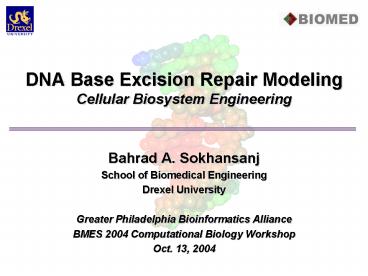DNA Base Excision Repair Modeling Cellular Biosystem Engineering PowerPoint PPT Presentation
1 / 27
Title: DNA Base Excision Repair Modeling Cellular Biosystem Engineering
1
DNA Base Excision Repair ModelingCellular
Biosystem Engineering
- Bahrad A. Sokhansanj
- School of Biomedical Engineering
- Drexel University
- Greater Philadelphia Bioinformatics Alliance
- BMES 2004 Computational Biology Workshop
- Oct. 13, 2004
2
Biological functions are controlled and
implemented by complex systems
- Multiple molecules interacting in different ways
at different scales - reaction
- combination
- transformation
- communication
- Accurately diagnosing problems with a cellular
process and controlling it to enhance function or
mitigate dysfunction requires understanding how
changing one or more factors affects the whole
system - Factors contribute unequally and dynamically
(Biological systems are NEITHER binary NOR steady
state)
3
DNA Base Excision Repair
http//greengenes.llnl.gov/repair/html/overview.ht
ml
4
Hypothesis Individual responses to DNA damage
are determined by multiple genes coding proteins
with different non-essentially modified functions
http//greengenes.llnl.gov/repair/html/overview.ht
ml
5
DNA damage and repair are phenotypes that can be
quantitatively measured
- Purified wt BER proteins are available and
protocols exist to obtain whole cell, nuclear,
and mitochondrial extracts - Fluorescent and radio-labeled oligos with damaged
sites (visualized on gels length difference
measures repaired) - Damage sites may be incorporated in specific
restriction sites to measure repair intermediates - Molecular beacons (fluorescent stem loop oligos)
may be used for in vivo (!) measurements of
repair kinetics - Actual cellular DNA damage single cell gel
electrophoresis Comet Assay (different damage
sites are measured after enzymatic treatment,
e.g. by Fpg, to produce strand breaks) - GC/LC-MS techniques are also available (elevated
damage measurements due to artifacts, but may be
useful for relative quantification)
6
In vitro Repair Kinetic Assays
S.L. Allinson et al. /DNA Repair 3 (2004) 2331
7
In vivo Repair Kinetic Assays
A. Maksimenko et al. /Bioch. Biophys. Res. Comm.
319 (2004) 240246
8
Base Excision Repair (BER) Pathway
9
In vitro Pathway ReconstitutionAP (abasic) site
repair
... compared with an in vitro pathway reconstruct
ion (Srivasta, et al. 1998).
10
Ape1-Polb Cooperativity
11
Polb Coordination
- consecutive dRp lyase and gap-filling steps may
be coordinated by the same Polb enzyme
12
Polb Coordination
13
Changing the Initial Number of Adducts(Im
starting to do this dynamically)
14
Whole Cell BER Model
15
Whole Cell BER Model
16
Parameters are from Experimental Data
17
Comparison with Cell Extract Assays
Supports hypothesis of Ape1-Ogg1
interaction8-oxoG lt U lt AP site repair rate
18
Short Patch Repair Dominates BER(depends on rx
conditions, substrate?)
19
Steady State Endogenous Lesion Formation
- AP Site Formation (spontaneous hydrolysis)
- 2-10,000 apurinic, 100-500 apyrimidinic
sites/cell/day - 8-oxoG Formation (metabolic ROS)
- 100-500 sites/cell/day
- Other oxidative base damage
- 20-100 sites/cell/day
- Does this mean there is a significant background
level of unrepaired intermediate repair
lesions? - Experimental measurements vary from 500 to
200,000 AP or 8-oxoG sites/cell (cell type
differences? experimental artifacts?) - Steady state BER model simulated for normal
endogenous damage rates (focus on 8-oxoG repair)
20
Experimental data for steady state oxidative DNA
lesion levels
Pouget, et al., Chem. Res. Toxicol., 13 541, 2000
Dizdaroglu, Free Radic. Medic. Biol., 32 1102,
2002
21
Steady State Predictions
Breaking point of about 125,000
8-oxoG/cell/day. (900 s.s. lesions/cell)
22
Dependence on Formation Rate
23
Sensitivity Analysis Results Are Robust
24
Why support lower experimental estimates?
- Assumptions of the modeling
- Michaelis-Menten kinetics, exclusion of product
inhibition - but, product inhibition is unlikely to be a
factor at low substrate formation rates, and may
enhance repair through baton passing - Only considered AP site and 8-oxoG repair
- but, cytosine deamination, SSB, etc. occur at
substantially lower levels, and kinetics are not
much slower - they can also be included in the model, with more
data - Mitochondria may be a source of lesions from ROS
- at least 100-fold fewer bases in mitochondria vs.
nucleus - experimental studies show insignificantly higher
levels of damage in mitochondria, and possibly
faster repair kinetics - Chromatin structure effects in vivo
- recent studies show substantially lower Polb and
DNA ligase activity (in vitro and in vivo) - we are currently incorporating this in our
modeling
25
Next step Measuring relative BER capacity for
protein variants found in population
26
Proposed Experiments for BER Variability
- Cell lines with known BER protein sequences /
expression (Coriell Institute HapMap Project) - Measure repair kinetics (repair time course) in
vitro (circular and linear oligoDNA) and in vivo
(molecular beacons) and capacity (DNA damage dose
response by SCGE) - Measure changes/differences in protein/gene
expression - Computational sequence analysis has predicted
potential protein function variants (Jones
Mohrenweiser) - Perturb cells by overexpressing repair proteins
and adding purified proteins to cell extracts
interpret results using our Whole Cell BER Model - Current collaborators Irene Jones (LLNL), Harvey
Mohrenweiser (UC-Irvine), David Wilson (NIA)
27
Acknowledgements
- David M. Wilson, III (NIH-National Institute on
Aging) - Irene Jones (BBRP) and Harvey Mohrenweiser
(UC-Irvine) - Yoshimura Matsumoto (Fox Chase Cancer Center)
- Emerging collaborations at Drexel and Beyond
- bahrad.sokhansanj_at_drexel.edu

